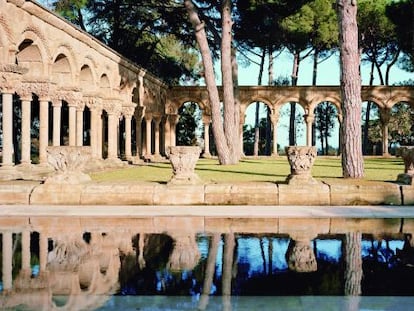A cloistered life: from paella with pigeon to a pool under the arches
Having finally gained access to property, experts agree stonework is authentic


The stunning 12th-century cloister that has stood inside a private home in Catalonia for 50 years, amid a garden complete with a swimming pool, has now been confirmed as authentic by scholars who were allowed on the premises to inspect it at the end of last week.
“It is an original work of the utmost importance,” said José Maria Pérez, president of Santa María la Real Foundation, which works to preserve Romanesque art in Spain. “It is originally from Castile, from someplace in Segovia or Burgos. [...] Its state of conservation is good, although erosion and moisture are damaging it. The swimming pool is doing a lot of damage to it.”
Pérez, also known by his cartoonist’s nom de plume of Peridis, was one of the experts allowed inside Mas del Vent, an estate in Palamós, Girona province, together with around 60 journalists to view this astounding structure up close. The owners’ decision to let them in came a few days after EL PAÍS broke the story and attracted attention from regional authorities and the media. Before that, the few people who knew about the cloister had been systematically denied access.
One of these people is Gerardo Boto, a scholar of Romanesque art who first unveiled the find at a recent art convention in Barcelona. For two years he had been trying to access the premises and check the authenticity of an architectural wonder that he is already comparing to the famous monastery of Santo Domingo de Silos in Burgos.

“It’s as though we were contemplating the eldest son of the Silos monastery,” he said. “I have a positive impression; the visual analysis could be conclusive, although an analysis of the stones might be necessary.”
Although the final verdict from the regional technicians— -an architect and two archeologists — is not out yet, it appears that not of all the cloister’s elements are entirely authentic. The columns seem more modern, while the capitals appear to be older.
Boto, the expert who first talked about the cloister in public, based his own findings on a photographic report published in a French magazine called AD, which showed the stone arcades running around the swimming pool. But far from recriminating the estate owners — a Swiss man named Kurt Englehorn and his wife Carmen — for keeping part of Spain’s heritage to themselves, Boto holds that “they should get a tribute or a prize, because for decades they took care to conserve it. Had it not been for them, who knows what state it would be in right now?”
While the home itself and the adjacent tower are listed on the Catalan regional government’s catalogue of Cultural Assets, there are no references to the cloister. It is the same story at Palamós town hall. The town has 88 elements on its protected list, including lighthouses, churches and even very old trees. But not the cloister.
Juan Manuel read about the cloister in EL PAÍS and knew it was the one from his childhood
The company that manages the estate said in a statement that the property was purchased by Hans Englehorn on July 23, 1958. “The owners never concealed any information about the origin [of the cloister]; it is available for public perusal at the Municipal Archive of Palamós.”
The local archive indeed contains a set of photographs showing how the structure went up on the estate in early 1959, after being trucked over from a warehouse in Madrid. According to the dates written on the back of the photographs, the cloister arrived here, in pieces, in late 1958 and the arcades went up between February and April of 1959.
Before that, it had sat for decades inside a plot of land in the Madrid neighborhood of Ciudad Lineal. So says Juan Manuel Ortiz, 86, who read the story about the cloister in EL PAÍS and immediately recognized the structure that he had lived next to as a child in Madrid. He and his son got in touch with this newspaper a few days ago to tell their story.
Juan Manuel’s father, Julián Ortiz, was an art restorer who was tasked with fixing up the cloister in 1931, after it was purchased by an antique dealer named Ignacio Martínez Martínez from an unknown seller. The dealer’s intention was to resell it to a wealthy American for five million pesetas (the price was later reduced to 3.5 million pesetas). The pieces were taken to an empty plot on Calle Ángel Muñoz, in what is now the district of Ciudad Lineal, and Julián Ortiz moved there with his wife and nine children so he could better oversee the restoration work.
The restorer Ortiz ended up in a concentration camp while the dealer moved to Barcelona
But the Civil War (1936-1939) altered those plans, and Ortiz ended up in a French concentration camp while the antique dealer moved to Barcelona. Ortiz returned to Spain in 1941 and the cloister was erected in situ in 1943. “Next to it we had a patch of striped eggplants, lights, water fountains and a pond that we all swam in,” remembers Juan Manuel, who was a child then.
Until 1958, the cloister was the setting for the Ortiz’s family reunions and social gatherings. “We liked to eat outdoors all together every Sunday, especially paella with pigeon.”
Then one day Federico Martínez, the antique dealer’s son, announced that he had found a new buyer for the cloister in Girona province. The structure was taken apart again and sent over by truck. “I always thought it was bought by someone named Otto Cherenverguer, or something like that, for some Catalan nuns, but now I find out through EL PAÍS that the owner is someone else,” says the 86-year-old Juan Manuel. “I wouldn’t want to die without seeing it one more time.”
Tu suscripción se está usando en otro dispositivo
¿Quieres añadir otro usuario a tu suscripción?
Si continúas leyendo en este dispositivo, no se podrá leer en el otro.
FlechaTu suscripción se está usando en otro dispositivo y solo puedes acceder a EL PAÍS desde un dispositivo a la vez.
Si quieres compartir tu cuenta, cambia tu suscripción a la modalidad Premium, así podrás añadir otro usuario. Cada uno accederá con su propia cuenta de email, lo que os permitirá personalizar vuestra experiencia en EL PAÍS.
¿Tienes una suscripción de empresa? Accede aquí para contratar más cuentas.
En el caso de no saber quién está usando tu cuenta, te recomendamos cambiar tu contraseña aquí.
Si decides continuar compartiendo tu cuenta, este mensaje se mostrará en tu dispositivo y en el de la otra persona que está usando tu cuenta de forma indefinida, afectando a tu experiencia de lectura. Puedes consultar aquí los términos y condiciones de la suscripción digital.
More information
Últimas noticias
More than 40 Democratic lawmakers urge Trump in a letter to stop his ‘attempts to undermine democracy in Brazil’
The journal ‘Science’ criticizes Trump’s anti-renewable energy policy: ‘The US is failing to benefit from its own innovations’
Cubans hope for a miracle as dengue and chikungunya spread
The long shadow of the father figure in the films of Rob Reiner
Most viewed
- Christian Louboutin: ‘Young people don’t want to be like their parents. And if their parents wear sneakers, they’re going to look for something else’
- Cartels in Mexico take a leap forward with narco-drones: ‘It is criminal groups that are leading the innovation race’
- ‘El Limones’ and the growing union disguise of Mexican organized crime
- Liset Menéndez de la Prida, neuroscientist: ‘It’s not normal to constantly seek pleasure; it’s important to be bored, to be calm’
- The low-cost creative revolution: How technology is making art accessible to everyone









































